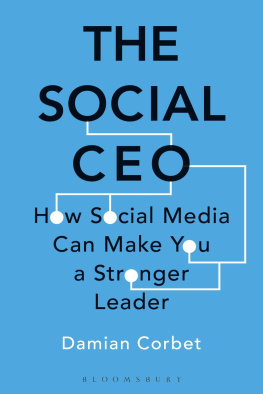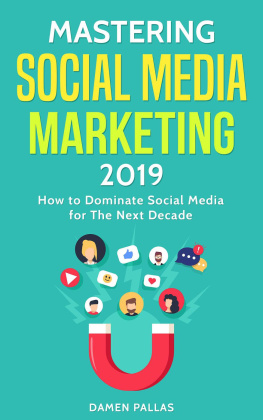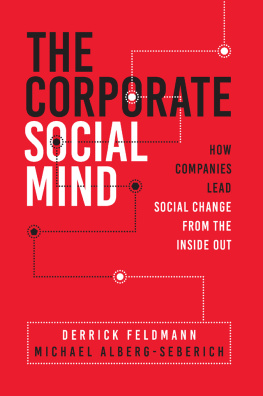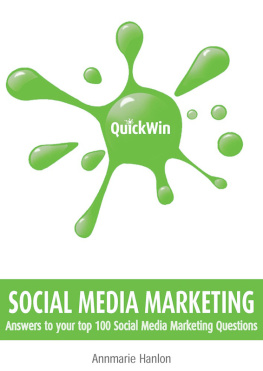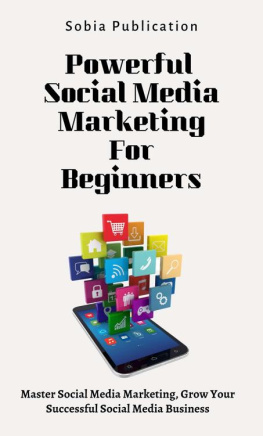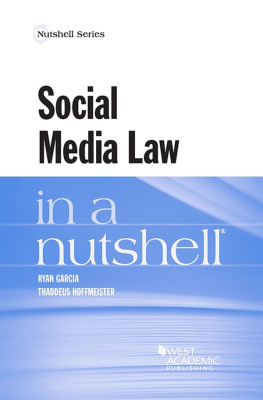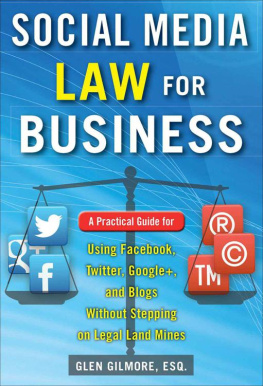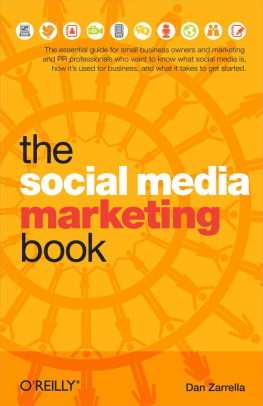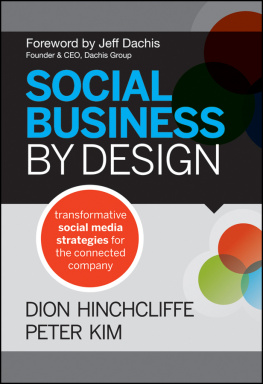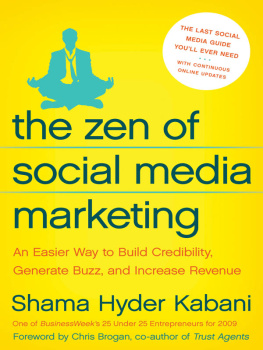
For Janina

Contents
There are many people who helped make this book happen.
I have to start by thanking Stephen Waddington, who edited Share This and Share This Too . The multi-author format of those books got me thinking about doing something similar. Stephen was also kind enough to meet me back in early 2017 to listen to my ideas and encouraged me to go for it.
Im also very grateful to Isabel de Clercq for inviting me to write a chapter for her book Social Technologies in Business. Connect Share Lead , which was published in 2018. Isabel proved that the multi-author format was not only possible but worked very well. This spurred me on to get The Social CEO completed.
Of course, the book would not have happened without all the amazing contributors, and I have to thank them all for believing in me and for writing their brilliant chapters. In strictly alphabetical order, they are Zoe Amar, Matt Ballantine, David Barker, Chris Bartley, Nicola Brentnall, Michelle Carvill, Mary Curnock Cook, Andrea Edwards, Katie Elizabeth, Paul Frampton Calero, Sarah Goodall, Tammy Gordon, Brett Gosper, Julia Hanigsberg, Samantha Kelly, Oliver Lawal, Tom Marchant, Chris Mason, Jan Owen, Charles Pender, Bob Pickard, Theo Priestley, Euan Semple, David Taylor, Mark Tercek, Martin Thomas, Jack Salzwedel and Brian Solis. It may seem a bit obvious to say that without them the book wouldnt exist, but without them the book wouldnt exist.
I must also thank Emily Bedford, Bloomsburys commissioning editor at the time I submitted my proposal (shes now moved into fiction publishing), for seeing the books potential and giving me a chance. Thanks also to her replacement Matt James for guiding me through the latter stages of the editorial process. Also at Bloomsbury, thanks must go to Kealey Ridgen and Emily Crowley Wroe for their sterling help with publicity and Giles Herman, the production editor. Finally, Id like to thank Leeladevi Ulaganathan, the senior project manager at Deanta Global, for her patience with all my last-minute corrections and changes. I really did take it down to the wire!
I couldnt finish without also mentioning the many people who have helped me along the way intentionally or otherwise. Some played a part long before the book was even an idea, when I was just toying with the concept of social media for leaders. Whether it was through listening to my ideas and not laughing, giving me encouragement and support, providing speaking opportunities, or kicking my butt, they all helped whether they know it or not. I cant name them all the list is too long but Id particularly like to thank Graeme Leith, Julian Stodd, Henrik Essen, Lina Duque, Kerstin Schinck, Sammy Revill, Andrew Ridge, Simon Bennet, Craig Murray, Mark Fulker, David Waller, Lisa Wallner, Peter Bangham, Katherine Livesey and Rob Dietrich. You all had a hand in it!
Ryan Holmes
In the short period between this books hardback publication and this subsequent paperback edition, we experienced a global shift in the way we live.
No one could have predicted (aside from Bill Gates, perhaps) that an invisible virus would cause the world to shut down almost overnight; that businesses would be forced to close their physical doors and shift to online models; that consumers would be confined to their homes for weeks upon weeks, their digital devices becoming their only access to the outside world; or that social media would become a lifeline in a crisis, proving if there was ever any doubt that commerce doesnt work without human connection.
The business world was already changing, long before Covid-19. Consumers were already shopping online, calling brands out on Twitter for negative customer service experiences and making vacation decisions based on Instagram posts. What the pandemic did unlike any other crisis of our generation was highlight social media as a commodity, one that had been taken for granted until almost all physical options of socializing were temporarily shut down . In doing so, it accelerated the way in which we adapt and rely on technology with a jarring speed and intensity. We quickly turned to livestreams, hangouts, Zoom calls and social media to continue to communicate, counter anxieties, keep operations flowing and spread a little hope.
In short, COVID-19 forced us to embrace our digital potential.
Unsurprisingly, in the face of the crisis, social media usage surged. A study of 25,000 consumers across 30 markets showed engagement increased 61 per cent over normal usage rates. And leaders who recognized and leveraged the power of social media shone.
Within days of the lockdowns we saw Jacinda Ardern, Prime Minister of New Zealand, take to Facebook Live after tucking her toddler into bed to field questions about what the new normal would look like. We saw Doug McMillon, President and CEO of Walmart, engage with his large social following to share a heartfelt letter to his employees, who had suddenly become frontline workers. He called them heroes during the crisis and applauded their courage publicly, with deep respect and admiration. And in regions hardest hit, like New York, we saw leaders like Governor Andrew Cuomo leverage the influence of celebrities like Jennifer Lopez and Alex Rodriguez to launch a multi-platform campaign encouraging New Yorkers to stay at home.
Not only were these leaders able to educate and assure their communities, alleviate anxiety and offer support at an uncertain time they were also able to show something that had perhaps been forgotten in the often shrewd world of business and politics: their humanity at a time when everyone was dialed in.
Social media is not a panacea, but it does represent an unprecedented way to reach people in real time, with accurate and actionable information. So what does this mean for businesses and the executives who lead them?
It means the legacy systems that the old guard clung to have come crashing down. It means that leaders who were slow to adapt to technology, who perhaps sat idle for too long and who are now in a digitally-transformed society have a steeper learning curve ahead. It also means that there has never been a greater opportunity for leaders to embrace social technology more fully and for better results.
This is a unique moment.
For people like me, who live and breathe this stuff, the confluence of people using social media to show true leadership throughout this crisis has been inspiring. Im hopeful this marks a turning point in the reinvention of a transformative technology, one where leaders embrace the power social media has to show a new side of business the human side. This means embracing humility, authenticity and transparency as cornerstones of both business and society because one doesnt work without the other.
We may well look back on this moment as a bright dividing line in the transformation of our relationship with connected, digital technologies and how they shaped not only the next chapter of business, but also society.
This book has contributions from many different people. Some are CEOs; some are former CEOs; some run their own small business; some are consultants; some have written books of their own; some are regular bloggers or contributors to websites like the Huffington Post and Forbes; some have never written an article in their lives.
Their writing styles vary; their backgrounds vary; their outlooks vary; their opinions vary. There is no homogenous voice. They may even disagree with each other sometimes. What they all have in common is a passionate belief in the power of social media for leaders.

